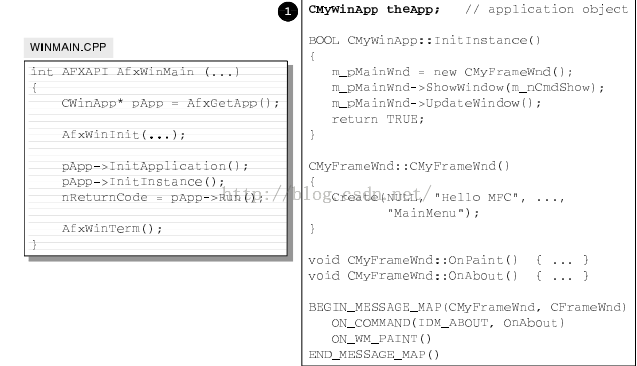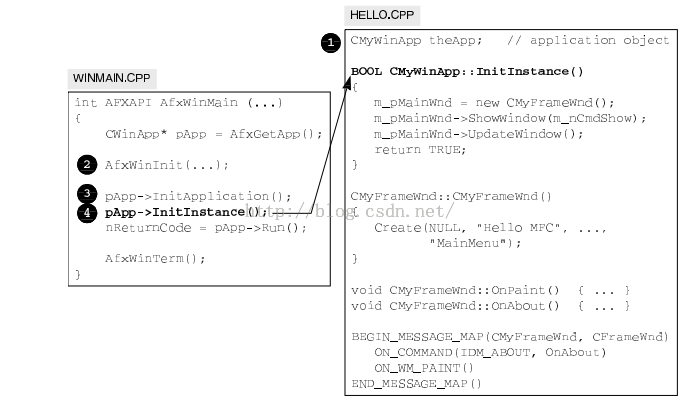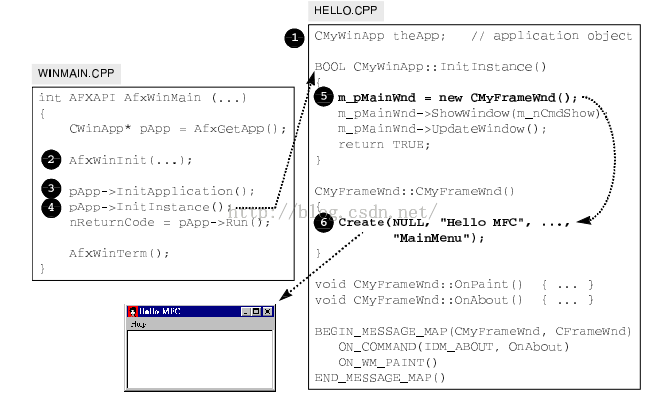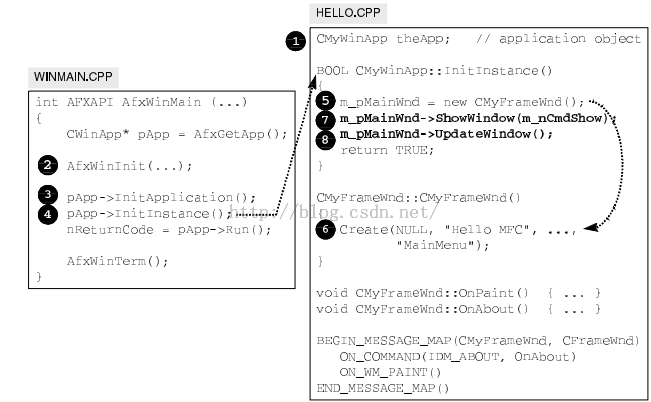MFC程序的运行细节剖析
MFC程序也是Windows程序,所以它应该也有一个WinMain,但是在程序中看不到它的踪影。其实在程序进入点之前,还有一个(而且仅有一个)全局对象(theApp),这就是所谓的Application object,当操作系统将程序加载并激活时,这个全局对象获得配置,其构造函数会先执行,比WinMain更早。
一 CWinApp取代WinMain
CWinApp的派生对象被称为application object,可以想见,CWinApp本身就代表一个程序本体。所谓程序本体是与程序本身有关而不与窗口有关的数据或动作。CWinApp类定义如下:
class CWinApp : public CWinThread
{
//startup args
HINSTANCE m_hInstance;
HINSTANCE m_hPrevInstance;
LPTSTR m_lpCmdLine;
int m_nCmdShow;
//Runing args
CWnd* m_pMainWnd;
CWnd* m_pActiveWnd;
LPCTSTR m_pszAppName;
LPCTSTR m_pszRegistryKey;
public:
LPCTSTR m_pszExeName; //executable name
LPCTSTR m_pszHelpFilePath; //default based on module path
LPCTSTR m_pszProfileName; //default based on app name
public:
virtual BOOL InitApplication();
//overrides for implementation
virtual BOOL InitInstance();
virtual int ExitInstance();
virtual int Run();
virtual BOOL OnIdle(LONG lCount);
};
传统意义上SDK程序的WinMain所完成的工作现在由CWinApp的三个函数完成:
virtual BOOL InitApplication();
virtual BOOL InitInstance();
virtual int Run();
那么WndProc函数到哪里去了呢?CFrameWnd主要用来掌握一个窗口,你几乎可以说它是用来取代SDK程序中的窗口函数的地位。MFC通过内建了一个所谓的Message Map机制,会把消息自动送到“与消息对应的特定函数”中去。有关Message Map实现机制请看另外一篇博客。
二 程序运行过程分析
如图所示,左半边MFC程序代码,右半部是我们自己写的程序代码。

当程序开始执行时,theApp这个全局对象产生,于是构造函数执行起来。CWinApp的构造函数如下
CWinApp::CWinApp(LPCSTR lpszAppName)
{
m_pszAppName = lpszAppName;
//initialize CWinThread state
AFX_MODULE_THREAD_STATE* pThreadState = AfxGetModuleThreadState();
pThreadState->m_pCurrentWinThread = this;
m_hThread = ::GetCurrentThread();
m_nThreadID = ::GetCurrentThreadId();
//initialize CWinApp state
AFX_MODULE_STATE* pModuleState = AfxGetModuleState();
pModuleState->m_pCurrentWinApp = this;
//in non-running state until WinMain
m_hInstance = NULL;
m_pszHelpFilePath = NULL;
........
}
CWinApp之中的成员变量将因为theApp这个全局对象的诞生而获得配置与初值。theApp配置完成后,WinMain登场。我们并未编写WinMain程序代码,这是MFC早就已经准备好并由链接器直接加到应用程序代码中:
extern “c” int WINAPI
_tWinMain(HINSTANCE hInstance, HINSTANCE hPrevInstance, LPTSTR lpCmdLine, int nCmdShow)
{
return AfxWinMain(hInstance, hPrevInstance, lpCmdLine, nCmdShow);
}
int AFXAPI AfxWinMain(HINSTANCE hInstance, HINSTANCE hPrevInstance, LPTSTR lpCmdLine, int nCmdShow)
{
int nReturnCode = -1;
CWinApp* pApp = AfxGetApp();
AfxWinInit(hInstance, hPrevInstance, lpCmdLine, nCmdShow);
pApp->InitApplication();
pApp->InitInstance();
nReturnCode = pApp->Run;
AfxWinTerm();
return nReturnCode;
}
其中,AfxGetApp是一个全局函数,定义域AFXWIN1.INL中:
_AFXWIN_INLINE CWinApp* AFXAPI AfxGetApp()
{ return afxCurrentWinApp; }
#define afxCurrentWinApp AfxGetModuleState()->m_pCurrentWinApp
根据之前描述的CWinApp::CWinApp()中的操作,可以知道AfxGetApp其实就是取得CMyWinApp对象指针。所以,AfxWinMain中这样的操作:
CWinApp* pApp = AfxGetApp();
pApp->InitApplication();
pApp->InitInstance();
nReturnCode = pApp->Run;
其实就相当于调用:
CMyWinApp::InitApplication();
CMyWinApp::InitInstance();
CMyWinApp::Run();
因而导致调用:
CWinApp::InitApplication();
CMyWinApp::InitInstance();//改写了父类的该方法,调用子类的
CWinApp::Run();
AfxWinInit——AFX内部初始化操作
AfxWinInit是继CWinApp构造函数之后的第一个操作。以下是它的操作摘要
BOOL AFXAPI AfxWinInit(HINSTANCE hInstance, HINSTANCE hPrevInstance, LPTSTR lpCmdLine, int nCmdShow)
{
ASSERT(hPrevInstance == NULL);
//set resource handles
AFX_MODULE_STATE* pState = AfxGetModuleState();
pState->m_hCurrentInstanceHandle = hInstance;
pState->m_hCurrentResourceHandle = hInstance;
//fill in the initial state for the application
CWinApp* pApp = AfxGetApp();
if(pApp != NULL)
{
//windows spcific initialization
pApp->m_hInstance = hInstance;
pApp->m_hPrevInstance = hPrevInstance;
pApp->m_lpCmdLine = lpCmdLine;
pApp->m_nCmdShow = nCmdShow;
pApp->SetCurrentHandles();
}
//initialize thread specific data
if(!afxContexIsDLL)
{
AfxInitThread();
}
return TURE;
}
CWinApp::InitApplication.
BOOL CWinApp::InitApplication()
{
if(CDocManager::pStaticDocManager != NULL)
{
if(m_pDocManager == NULL)
{
m_pDocManager = CDocManager::pStaticDocManager;
}
CDocManager::pStaticDocManager = NULL;
}
if(m_pDocManager != NULL)
{
m_pDocManager->AddDocTemplate(NULL);
}
else
{
CDocManager::bStaticInit = FALSE;
}
return TRUE;
}
这些都是MFC为了内部管理而做的。
CMyWinApp::InitInstance

继InitApplication之后,调用InitInstance即调用CMyWinApp::InitInstance();
也就是调用我们重写后的InitInstance函数。
CFrameWnd::Create产生主窗口(并先注册窗口类)

CMyWinApp::InitInstance一开始new了一个CMyFrameWnd对象,准备用作主框窗口的c++对象。会调用CMyFrameWnd类的构造函数,从而调用Create函数它将产生一个窗口。在调用Create函数的过程中Create会调用CreateEx,CreateEx函数实现如下:
BOOL CWnd::CreateEx(DWORD dwExstyle, LPCTSTR lpszClassName,
LPCTSTR lpszWindowName, DWORD dwStyle,
int x, int y, int nWidth, int nHeight,
HWND hWndParent, HMENU nIDorHMenu, LPVOID lpParam)
{
//allow modification of several common create parameters
CREATESTRUCT cs;
cs.dwExstyle = dwExStyle;
cs.lpszClass = lpszClassName;
cs.lpszName = lpszWindowName;
cs.style = dwStyle;
cs.x = x;
cs.y = y;
cs.cx = nWidth;
cs.cy = nHeight;
cs.hwndParent = hWndParent;
cs.hMenu = nIDorHMenu;
cs.hInstance = AfxGetInstanceHandle();
cs.lpCreateParams = lpParam;
PreCreateWindow(cs);
AfxHookWindowCreate(this);
HWND hWnd = ::CreateWindow(.....);
........
}
到这里可能熟悉SDK编程的都会问那么窗口类呢,其实窗口类在Create函数调用时窗口类参数传的NULL代表将以MFC内建的窗口类产生一个标准的外框窗口。
窗口显示与更新

CMyFrameWnd::CMyFrameWnd结束后,窗口已经诞生出来;程序流程又回到了CmyWinApp::InitInstance,于是调用ShowWindow函数令窗口显示出来,并调用UpdateWindow函数令hello程序发送出WM_PAINT消息。
我们很关心这个WM_PAINT消息是如何送到窗口函数的手中。而且,窗口函数又在哪里?
MFC程序是不是也像SDK程序一样,有一个GetMessage/DispatchMesage循环?
CWinApp::Run
程序运行到这,接下来将执行pApp->Run()即相当于调用CMyWinApp::Run();
Run函数是CWinApp的一个虚函数,而且我们没有改写它,所以上述操作相当于调用CWinApp::Run();通过研读Run函数实现代码它会调用PumpMessage()函数,在这个函数中就是真正处理消息循环函数。
三 整理
1.程序的诞生:
Application object 产生,内存于是获得配置,初值亦设立了。AfxWinMain
执行AfxWinInit,后者有调用AfxInitThread,把消息队列尽量加大到96。
AfxWinMain执行InitApplication。这是CWinApp的虚函数,我们通常不改写它。
AfxWinMain执行InitInstance。这是CWinApp的虚函数,我们必须改写它。
CMyWinApp::InitInstance new 了一个CMyFrameWnd对象。
CMyFrameWnd构造函数调用Create,产生主窗口。
回到InitInstance中继续执行ShowWindow,显示窗口。
执行UpdateWindow,于是发出WM_PAINT。
回到AfxWinMain,执行Run,进入消息循环。
2.程序开始运行:
程序获得WM_PAINT消息(藉由CWinApp::Run中的::GetMessage循环)。
WM_PAINT经由::DispatchMessage送到窗口函数CWnd::DefWindowProc
中。
CWnd::DefWindowProc将消息传递过消息映射表格(Message Map)。
传递过程中发现有相符项目,于是调用项目中对应的函数。此函数是应用程序利用BEGIN_MESSAGE_MAP和END_MESSAGE_MAP之间的宏设立起来的。
标准消息的处理程序亦有标准命名,例如WM_PAINT必然由OnPaint处理。
3.程序的死亡
使用者单击【File/Close】,于是发出WM_CLOS。
CMyFrameWnd并没有设置WM_CLOSE处理程序,于是交给默认的处理程序。
默认的处理函数对于WM_CLOSE的处理方式是调用::DestroyWindow,并因
而发出WM_DESTROY。
CWinApp::Run收到WM_QUIT后会结束其内部消息循环,然后调用
ExitInstance,这是CWinApp的一个虚拟函数。
最后回到AfxWinMain,执行AfxWinTerm,结束程序。
版权声明:本文为博主原创文章,未经博主允许不得转载。